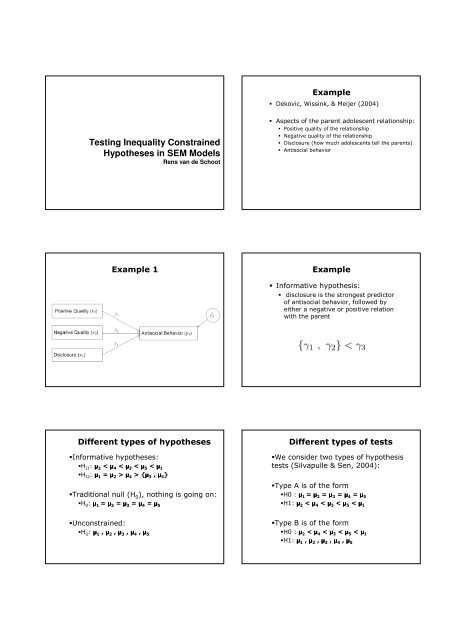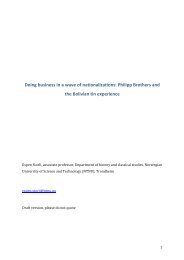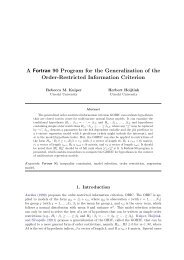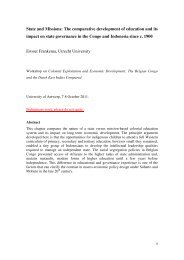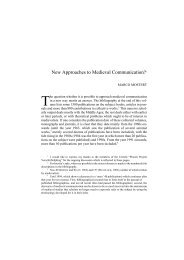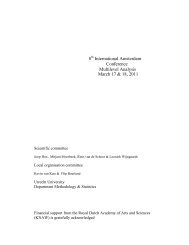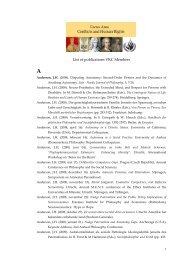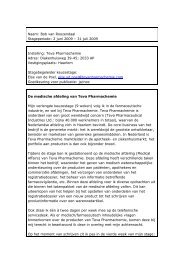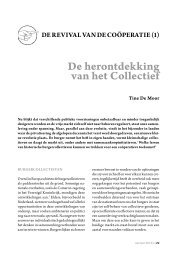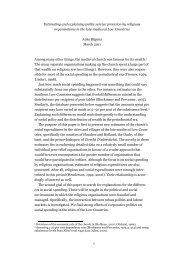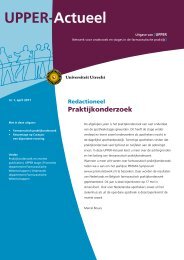Testing Inequality Constrained Hypotheses in SEM Models
Testing Inequality Constrained Hypotheses in SEM Models
Testing Inequality Constrained Hypotheses in SEM Models
Create successful ePaper yourself
Turn your PDF publications into a flip-book with our unique Google optimized e-Paper software.
Example<br />
Dekovic, Wiss<strong>in</strong>k, & Meijer (2004)<br />
<strong>Test<strong>in</strong>g</strong> <strong>Inequality</strong> <strong>Constra<strong>in</strong>ed</strong><br />
<strong>Hypotheses</strong> <strong>in</strong> <strong>SEM</strong> <strong>Models</strong><br />
Rens van de Schoot<br />
Aspects of the parent adolescent relationship:<br />
Positive quality of the relationship<br />
Negative quality of the relationship<br />
Disclosure (how much adolescents tell the parents)<br />
Antisocial behavior<br />
Example 1<br />
Example<br />
Informative hypothesis:<br />
disclosure is the strongest predictor<br />
of antisocial behavior, followed by<br />
either a negative or positive relation<br />
with the parent<br />
Different types of hypotheses<br />
Informative hypotheses:<br />
H I1 : μ 2 < μ 4 < μ 3 < μ 5 < μ 1<br />
H I2 : μ 1 = μ 2 > μ 4 > {μ 3 , μ 5 }<br />
Traditional null (H 0 ), noth<strong>in</strong>g is go<strong>in</strong>g on:<br />
H 0 : μ 1 = μ 2 = μ 3 = μ 4 = μ 5<br />
Different types of tests<br />
We consider two types of hypothesis<br />
tests (Silvapulle & Sen, 2004):<br />
Type A is of the form<br />
H0 : μ 1 = μ 2 = μ 3 = μ 4 = μ 5<br />
H1: μ 2 < μ 4 < μ 3 < μ 5 < μ 1<br />
Unconstra<strong>in</strong>ed:<br />
H U : μ 1 , μ 2 , μ 3 , μ 4 , μ 5<br />
Type B is of the form<br />
H0 : μ 2 < μ 4 < μ 3 < μ 5 < μ 1<br />
H1: μ 1 , μ 2 , μ 3 , μ 4 , μ 5
What to do with <strong>in</strong>formative<br />
hypotheses?<br />
What to do with <strong>in</strong>formative<br />
hypotheses?<br />
Difficult to evaluate <strong>in</strong>formative<br />
hypothesis us<strong>in</strong>g traditional null<br />
hypotheses test<strong>in</strong>g:<br />
H0 : μ 1 = μ 2 = μ 3 = μ 4 = μ 5<br />
H1: not H0<br />
Why:<br />
Not always <strong>in</strong>terested <strong>in</strong> null hypothesis<br />
‘accept<strong>in</strong>g’ alternative hypothesis -> no<br />
answer<br />
No direct relation between H0 and<br />
<strong>in</strong>formative hypothesis<br />
What to do with <strong>in</strong>formative hypotheses?<br />
Classical model selection criteria?<br />
Information criteria (ICs):<br />
Akaike's IC, or AIC, (Akaike, 1973,1981)<br />
Bayesian IC, or BIC, (Schwarz, 1978)<br />
Deviance IC, or DIC, (Spiegelhalter et al, 2002)<br />
What should we then do?<br />
Parametric bootstrap method <strong>in</strong> Mplus<br />
Van de Schoot, R., Hoijt<strong>in</strong>k, H. & Deković, M.<br />
(2010). <strong>Test<strong>in</strong>g</strong> <strong>Inequality</strong> <strong>Constra<strong>in</strong>ed</strong> <strong>Hypotheses</strong><br />
<strong>in</strong> <strong>SEM</strong> <strong>Models</strong>. Structural Equation Model<strong>in</strong>g, 17,<br />
443–463.<br />
Van de Schoot , R. & Strohmeier, D. (under<br />
review). <strong>Test<strong>in</strong>g</strong> <strong>in</strong>equality constra<strong>in</strong>ed hypotheses<br />
<strong>in</strong> <strong>SEM</strong> to Increase Power: An illustration<br />
contrast<strong>in</strong>g classical hypothesis test<strong>in</strong>g with a<br />
parametric bootstrap approach<br />
Bootstrap procedure with<br />
plug-<strong>in</strong> p-values<br />
<strong>SEM</strong> is often used <strong>in</strong> practice<br />
Order restricted <strong>in</strong>ference <strong>in</strong> <strong>SEM</strong> is new<br />
<strong>Test<strong>in</strong>g</strong> hypothesis not available<br />
Solution: parametric bootstrap<br />
Likelihood ratio test<br />
However: calibration of plug-<strong>in</strong> p-value<br />
needed<br />
In Mplus:<br />
Mplus & constra<strong>in</strong>ts<br />
MODEL:<br />
anti on pos (b1)<br />
neg (b2)<br />
dis (b3);<br />
MODEL CONSTRAINT:<br />
b1 < b3;<br />
b2 < b3 ;
Mplus & constra<strong>in</strong>ts<br />
Parametric bootstrap: Step 1<br />
DATA: FILE = data.dat;<br />
VARIABLE:<br />
NAMES ARE anti pos neg dis dis;<br />
MODEL:<br />
anti on pos (b1)<br />
neg (b2)<br />
dis (b3);<br />
MODEL CONSTRAINT:<br />
b1 = b2;<br />
b2 = b3;<br />
SAVE:<br />
RESULTS ARE D:\vb_1\results_data_H0_vb1.txt;<br />
ESTIMATES ARE D:\vb_1\estimates_vb1.txt;<br />
DATA: FILE = data.dat;<br />
Step 2<br />
VARIABLE: NAMES ARE anti pos neg dis;<br />
MODEL:<br />
anti on pos (b1)<br />
neg (b2)<br />
dis (b3);<br />
MODEL CONSTRAINT:<br />
b1 < b3;<br />
b2 < b3 ;<br />
SAVE: RESULTS ARE D:\vb_1\results_data_H1_vb1.txt;<br />
MONTECARLO:<br />
NAMES ARE anti pos neg dis;<br />
Step 3<br />
NOBSERVATIONS = 603;<br />
NREPS = 1000;<br />
POPULATION = D:\vb_1\estimates_vb1.txt;<br />
REPSAVE= ALL;<br />
SAVE= D:\vb_1\rep_nieuw_vb1_*.txt;<br />
RESULTS = D:\vb_1\results_vb1.txt;<br />
MODEL POPULATION: anti on pos neg dis;<br />
MODEL: anti on pos neg dis;<br />
Step 4<br />
DATA: FILE = D:\vb_1\rep_nieuw_vb1_list.txt;<br />
TYPE = MONTECARLO;<br />
VARIABLE: NAMES ARE anti pos neg dis ;<br />
MODEL:<br />
anti on pos (b1)<br />
neg (b2)<br />
dis (b3);<br />
MODEL CONSTRAINT:<br />
b1 = b3; b2 = b3 ;<br />
SAVE: RESULTS ARE D:\vb_1\results_simulatie_H0_vb1.txt;<br />
Step 5<br />
DATA: FILE = D:\vb_1\rep_nieuw_vb1_list.txt;<br />
TYPE = MONTECARLO;<br />
VARIABLE: NAMES ARE anti pos neg dis ;<br />
MODEL:<br />
anti on pos (b1)<br />
neg (b2)<br />
dis (b3);<br />
MODEL CONSTRAINT:<br />
b1 < b3; b2 < b3 ;<br />
SAVE: RESULTS ARE D:\vb_1\results_simulatie_H1_vb1.txt;
Data sets<br />
Results are 4 data sets:<br />
Likelihood of data under H0<br />
Likelihood of data under H1<br />
1000 times results of simulated<br />
datasets generated under H0 and<br />
evaluated under H0<br />
1000 times results of simulated<br />
datasets generated under H0 but<br />
evaluated under H1<br />
Data sets<br />
Likelihood ratio test:<br />
Between data H0 and H1<br />
For each simulated data set<br />
Count the number of simulated results<br />
that have a larger number then the data<br />
result<br />
Function <strong>in</strong> R<br />
Bootstrap procedure with<br />
plug-<strong>in</strong> p-values<br />
Example of <strong>in</strong>formative hypotheses<br />
Different types of hypotheses<br />
What to do with <strong>in</strong>formative hypotheses?<br />
Why not to use classical null hypothesis test<strong>in</strong>g?<br />
Why not to use classical model selection criteria?<br />
What should we then do?<br />
Technical Intermezzo:<br />
What is bootstrapp<strong>in</strong>g?<br />
What is a p-value and how to obta<strong>in</strong> one?<br />
Mplus & constra<strong>in</strong>ts<br />
Bootstrap procedure with plug-<strong>in</strong> p-values<br />
Why the alpha level needs to be calibrated.<br />
Why the alpha level needs to be<br />
calibrated<br />
Frequency Properties of the p-values<br />
Asymptotically uniform [0,1] under H0<br />
Prob(p < α* | H0) = α<br />
Double bootstrap procedure to<br />
estimate α*<br />
Calibration of plug-<strong>in</strong> p-value<br />
Results<br />
Hypothesis test type A<br />
Type B
Calibration of plug-<strong>in</strong> p-value<br />
Distribution is not uniform<br />
5th percentile of generated plug-<strong>in</strong> p-<br />
values has a plug-<strong>in</strong> p-value of .038<br />
α* = .038 <strong>in</strong>stead of traditional .05<br />
Prob(p < .038 | H0) = .05<br />
Bootstrap procedure with<br />
plug-<strong>in</strong> p-values<br />
Example of <strong>in</strong>formative hypotheses<br />
Different types of hypotheses<br />
What to do with <strong>in</strong>formative hypotheses?<br />
Why not to use classical null hypothesis test<strong>in</strong>g?<br />
Why not to use classical model selection criteria?<br />
What should we then do?<br />
Technical Intermezzo:<br />
What is bootstrapp<strong>in</strong>g?<br />
What is a p-value and how to obta<strong>in</strong> one?<br />
Mplus & constra<strong>in</strong>ts<br />
Bootstrap procedure with plug-<strong>in</strong> p-values<br />
Why the alpha level needs to be calibrated.<br />
Conclusion<br />
Contact<br />
<strong>Inequality</strong> constra<strong>in</strong>ts can be tested <strong>in</strong><br />
<strong>SEM</strong><br />
Calibration is needed!<br />
Rens van de Schoot<br />
www.fss.uu.nl/ms/schoot<br />
A.g.j.vandeschoot@uu.nl<br />
Implement this procedure <strong>in</strong> the<br />
software of Mplus


